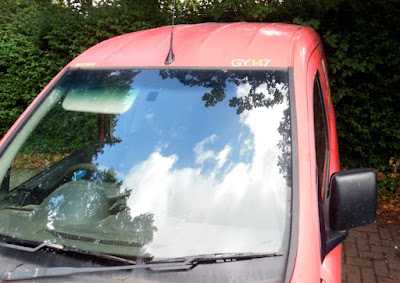Brigg shares something with the great trawler fleet which Grimsby - the world famous and bustling fishing port - had in the 19th and 20th centuries when catches were at their zenith.
Local postal vans are currently numbered in the same manner as Grimsby fishing vessels which sailed the high seas to drop their nets.
We recently photographed van GY 147 parked on Station Road, Brigg.
Identification codes are applied to the bodywork; they are not the DVLC vehicle registrations.
For comparison, also seen here is fishing trawler GY 590 in Grimsby during the early 1970s - an interesting picture of the Vionova from our family archive.
Brigg Blog spotted post vans not far from the old Post Office (and now-closed Hewson House) on our way back from a visit to the town's railway station last week.
It reminded us that, in the mid-1960s, we used to walk up Station Road (then known as Station Approach) to watch early evening fish trains loaded with Grimsby's finest pass through on their way towards Sheffield.
Steam locos were being phased out at the time, but the smell of their exhaust and engine oil mixed with the fishy aroma from the railway vans to create a smell which lingered long after the train had disappeared into the distance and bridged the Old River Ancholme.
Massive tonnages of fish were moved through Brigg by the Manchester, Sheffield & Lincolnshire Railway in the second half of the 19th century.
This continued through the Great Central and then London, North Eastern Railway eras, and long after British Railways had been established in 1948.
However, road haulage offered increasingly stiff competition, and British Rail ceased running any fish trains in the late 1960s, resulting in all loads of cod, haddock and other species being delivered by lorries.
Big imports from abroad keep the fishing industry supplied today.
Our family never went short of fish in the late 1950s while Dad worked a small signalbox which controlled access to Grimsby Fish Docks.
A steam-powered shunting loco would attach fish vans to the rear of some passenger trains which stopped at Grimsby Docks station.
Perhaps this explains why, in the early 1970s, he returned to photograph some of the remaining trawlers.
That decade saw a sad decline in the number operating from the port.
Returning to the present day, it may be that the 'GY' numbering method for local delivery vans is being phased out.
A much newer 'postie' vehicle observed recently in Brigg carried identification lettering 321 CV7 above the front window.
Or was this van just visiting from another area?
A trawl through the worldwide web reveals GY 147 was carried by a number of trawlers over the years, including:
Flirt (lost at sea in 1898).
Earl Hereford (built 1906).
Langanes (wrecked off Iceland in 1935).
Vascama (scrapped in 1962).
During many visits to The Garden 'chippie' (on Grammar School Road) we've admired a large and colourful wallchart showing traditional fishing grounds of the northern hemisphere, including Fisher (near Denmark)!
Identification codes and the vehicles they belong to - photographed recently while parked on Station Road, Brigg.




